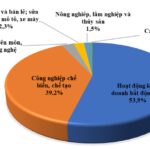
Vietnam’s economy continued its upward trajectory in the second quarter of 2024, with real GDP growing by 6.93% year-on-year, according to data released by the General Statistics Office (GSO). This builds on the strong growth of 5.87% (revised upwards from the previously reported figure) in the first quarter of 2024 and 6.72% in the fourth quarter of 2023, far outpacing the 4.05% growth rate recorded in the same quarter of 2023.
The country’s economic growth for the first half of 2024 stood at an impressive 6.42%, a significant improvement over the 3.84% recorded in the same period last year. This positive performance bodes well for the remainder of the year, following a challenging 2023.
Both the manufacturing and services sectors remained the key drivers of economic activity, while external trade maintained its robust momentum in the second quarter. The upward trend in semiconductor sales since mid-2023 suggests that this momentum could continue for another quarter or two.
While the outlook remains positive, the pace of growth may moderate in the second half of the year. UOB notes that the strong performance in the second quarter, which exceeded both UOB and market expectations, sets a high base for comparison with the latter half of 2023. Additionally, risks persist, including the conflict between Russia and Ukraine and tensions in the Middle East, which could disrupt global trade and energy markets.
However, a recovery in semiconductor demand, steady growth in China and Southeast Asia, and the potential for monetary policy easing by major central banks are all factors that bode well for Vietnam’s prospects. UOB maintains its forecast of 6% growth for Vietnam in 2024, in line with the government’s target range of 6.0-6.5%.
Turning to inflation, the recovery in domestic spending has exerted upward pressure on consumer prices, with Vietnam’s headline CPI rising for the fifth consecutive quarter, reaching 4.39% year-on-year in the second quarter of 2024 (up from 3.77% in Q1). In contrast, core CPI (excluding food, energy, and goods managed by the government such as education and healthcare) decelerated for the fifth straight quarter to 2.69% (from 2.81% in Q1).
The GSO attributed the rise in headline inflation primarily to increases in food and housing costs, particularly due to higher pork prices (as a result of the African swine fever outbreak in late 2023), electricity rates, and healthcare and education services.
Looking ahead, one factor that could influence inflation is the planned minimum wage increase of 6% from July 2024, slightly higher than the 5.88% rise in July 2022. Vietnam has consistently raised the minimum wage in recent years, with increases of 7.3%, 6.5%, and 5.3% in 2017, 2018, and 2019, respectively.
Given the recent depreciation of the Vietnamese dong against a strengthening US dollar and rising inflationary pressures, the State Bank of Vietnam (SBV) is likely to adopt a cautious approach to any policy rate changes. Taking into account the potential for a moderation in growth momentum in the latter half of 2024, UOB expects the SBV to maintain the refinancing rate at its current level of 4.5%.
With the European Central Bank already cutting rates in June and the US Federal Reserve possibly shifting towards a more accommodative stance in the coming months, there may be room for the SBV to follow suit. For now, instead of further rate cuts, the government is focusing on non-rate measures to support the economy.
Hàn Đông
‘King of spenders’ Phan Minh Thong warns of ‘shocking’ changes in the US market from a $500,000 pho bowl perspective.
“In the US, a bowl of pho costs about $15-18, plus a $20 tip (around 500,000 Vietnamese dong). Compared to Vietnam, where breakfast in Saigon or Hanoi costs around 50,000 dong per meal, and a plate of banh cuon with all the toppings in Hai Phong costs 20,000 dong,” Mr. Thong recounted.
















